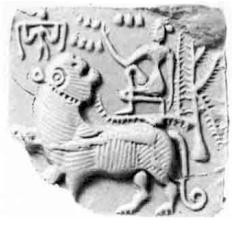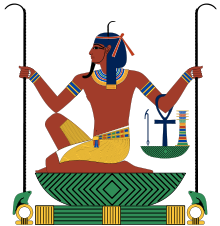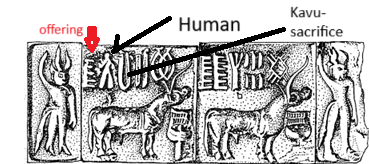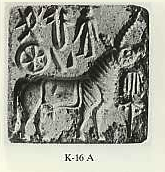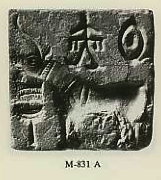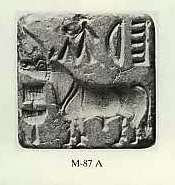Tamil Nadu graffiti The Ka symbol indicates the soul.
Tamil Nadu Graffiti – The “Ka” symbol indicates the “soul”
The above-given picture shows the graffiti symbol from Hyderabad. Reference picture no. 2.10, page no 101, book of Rajan. (1) This hand symbol is similar to the “Ka” symbol of Egyptian hieroglyphics. In this Hyderabad graffiti, the hand symbol is drawn in an inverted way, whereas the Egyptian symbol is drawn vertically. It is worth noting that Gurumurthy has also observed a similarity between the hand symbol of Egypt and hand symbols found in India. Page no 167 of his book. (2) Unfortunately, he did not investigate this issue further. This ‘Ka” symbol forms the backbone of the entire IVC script.
The above-given ka symbol represents the deceased person’s soul. Most likely, the Hyderabad hand symbol also represents the deceased person’s “Ka” (soul).
The symbol above is a modified form of the Egyptian symbol used in IVC. There are many other variants of this symbol.
The above-given graffiti symbols are from the book of Gurumurthy. (Ref. Page no. 58, Deciphering the Indus Script). (2) Serial number 30, Gurumurthy identified the symbol as a forearm. But, I disagree with his view. It resembles a sacrificial pot in which the blood of sacrificed animals is offered to gods and spirits.
However, in serial no. 38 …page. No. 60 is a similar hand symbol; he identifies it as an elephant’s trunk, which is incorrect. It is worth noting that the vocabulary of graffiti symbols is limited, and there will be considerable variations in the symbols drawn. Because the symbols are scratched on fully baked pots, scratching is difficult, and the lines are drawn in a sharp-edged manner, resulting in an unappealing drawing shape. The Indus seals, commonly made of steatite— a soft stone — were crafted by carving designs with incised lines and then pressing them onto smooth surfaces, such as clay, to create an imprint. Hence, the picture quality is good in IVC seal inscriptions.
Another example of misidentification by Gurumurthy is on page no. 69. serial no. 71. He has identified a symbol as a boat; in reality, it is the sacrificial pot symbol.
In the graffiti on page 132. Gurumurthy says this symbol indicates god, which needs verification.
Whereas this branch symbol is identified as a spear (vel -Tamil) by Gurumurthy. I disagree with his interpretation. In my opinion, it follows the same meaning as in IVC inscriptions. In the IVC script, a branch symbol indicates the word “Sastha”. Sastha means god. Read my article, ‘Branch symbol indicates the word Sastha’ (3) For more information.
| Kavu means sacrifice | Mountain god Varuna | Sastha means god | Read from left to right. | |
| Kavu | Sastha | Varuna | Read from right to left | |
| sastha | kavu | Varuna | Read from right to left | |
| Varuna | sastha | kavu | Read from right to left | |
| pithru | sastha | kavu | Read from right to left |
Table 1 Sanur graffiti
The table above is an extract from the Sanur graffiti. This extract is from the book of Gurumurthy, page no. 134 and 135. (2) This extract gives some details about the direction of graffiti writing. It can be seen that the direction of writing is bidirectional, allowing for both right-to-left and left-to-right movements. However, the meaning can be well understood because it is an ideogramic way of writing, not phonetic writing. Just like the IVC script, the TN graffiti is also written in an ideographic way.
From Table 1, it can be concluded that the “” symbol indicates the word “kavu”, which conforms to IVC scripts. Read my article, “Kavu Symbol Indicates Sacrifice in Indus Inscriptions,” for more information. (4)
Gurumurthy says the above graffiti is a boat. Refer to page 110 of his book. However, it appears to be a hand offering conical bread. The first graffiti is a hand, but the second graffiti resembles a boat; however, I still consider this graffiti to be a hand. Because the priest who drew this graffiti did not have control over the sharp instrument used to make the scratches on the pot. Hence, the hand symbol looks like a boat. Conical bread is significant in Egypt as well as in the Indus Valley Civilization (IVC). The conical symbol represents everlasting life to the deceased. Read my article: “The cone symbol means – given everlasting life.” (5)
Note the cone-like bread offered by the pharaoh. (5) The cone bread he offers resembles the one marked in the Tamil Nadu graffiti.
References
1. Rajan., K. Thonmai Tamizh Iyal (in Tamil). Chennai : International Institute of Tamil Studies., 2018.
2. Gurumurthy .S. Deciphering the Inus script. Chennai. : University of Madras, Chennai., 1999.
3. Jeyakumar(Sastha). Branch_symbol_indicates_the_word_Sastha. academia.edu. [Online] 2016. https://www.academia.edu/31658123/Branch_symbol_indicates_the_word_Sastha..
4. Jeyakumar(Kavu). Kavu symbol indicates sacrifice in Indus inscriptions. www.academia.edu. [Online] 2016. https://www.academia.edu/8612715/Kavu_symbol_indicates_sacrifice_in_Indus_inscriptions.
5. Jeyakumar(Cone-symbol). The cone symbol means given eternal life. https://www.academia.edu. [Online] 2018. https://www.academia.edu/41094648/Cone_symbol_means_Given_eternal_life.


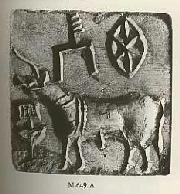

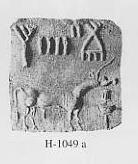
 could be the modified version of the Egyptian Palm branch hieroglyph.
could be the modified version of the Egyptian Palm branch hieroglyph.
